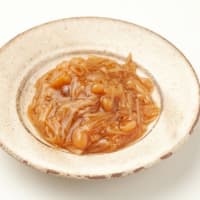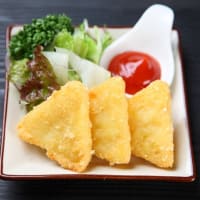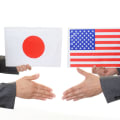Me Hey, Dali! What do you think about Momiji-gari? Is it popular also in the US? But first of all, do you even know what Momiji-gari is? I found on the Internet that it is called leaf-peeping in English.
私 ねえダリちゃん! 紅葉狩りについてどう思う? アメリカでも人気? でもそもそも紅葉狩りって何か知ってる? 英語でleaf-peepingって呼ばれるってネットで見たんだけど。
Dali What? What is “leaf-peeping”? That’s absolutely wrong! Ridiculous! It may be Singapore English. It’s not true English. Peeping means nozoku-koto. Peeping is to look at somebody secretly.
ダリちゃん なんだって! leaf-peepingって何? 絶対間違ってるよ! 滑稽だね! シンガポール英語じゃないの。まともな英語じゃないよ。peepingとは覗くこと。peepingは誰かをこっそりと見ること。
Me Then what do you call Momiji-gari in English?
私 じゃあ、紅葉狩りって英語で何と言うの?
Dali We don’t have a word for this activity because, for us, it’s not really thought of as an “activity.” Indeed, we enjoy Momijis in our gardens, but we don’t particularly make definitive plans to go somewhere for the express purpose of viewing fall foliage. It’s not like skiing or playing tennis; it’s not like going to the circus or a sports event.
ダリちゃん このアクティビティーに対する単語はないよ。だってわしらにとってはそれは本当の「アクティビティー」とは思われていないもの。 確かにわしらは庭の紅葉を楽しむけど、紅葉を見るという明確な目的でどこかに行くというしっかりした計画をことさら立てることは無いよ。スキーやテニスをするという感じではないし、サーカスやスポーツイベントに行くという感じでもない。
Me Humm…
私 ふ~ん……
Dali Instead of saying, “Let’s go Momiji-gari,” we say, “Let’s go to the mountains to have a picnic. The forests are filled with beautiful autumn colors. This makes the picnic so enjoyable.”
ダリちゃん 「レッツゴー紅葉狩り」という代わりに、わしらは「山にピクニックに行こう。森は美しい満開の紅葉。とても楽しいピクニックになるよ」と言う。
Me Humm…
私 ふ~ん……
Dali The same is true for Hanami. Instead of saying, “Let’s do Hanami,” we say, “Let’s go to the park and drink ourselves silly. The beautiful sakura flowers will lend a happy buzz to the atmosphere, which will make our drunken escapades so enjoyable.”
ダリちゃん 花見も同じ。「レッツドゥー花見」という代わりに、わしらは「公園に行って理性がなくなるまで飲もう。美しい桜の花でワクワクな雰囲気になってお酒を飲んでの無礼講をとっても楽しめるよ」と言う。

Autumn leaves in Hakone
Me I like drunken escapades…
私 僕はお酒を飲んでの無礼講が好き……
Dali So, the answer to your question is much more than just a simple word-to-word translation.
ダリちゃん だからあなたの質問の答えは、ただの単純な単語対単語の翻訳以上の意味があるということだ。
Me Sorry, I don’t understand.
私 ごめん、何言ってるかわからないんだけど。
Dali Well, let me give you an example that even a dummy can understand. Suppose I go to a restaurant that always plays beautiful background music. I go to the restaurant for the food, not for the music. I go to the restaurant because it serves the best pizza. But, of course, I enjoy also the music.
ダリちゃん そうだね、馬鹿でもわかるように例を挙げるね。わしがいつも美しいBGMを流しているレストランに行くとしよう。わしは食事をしにそのレストランへ行くのであって音楽を聴くために行くのではない。そこのピザが最高だから行くのさ。でももちろん音楽も楽しむ。
Me Well, it doesn’t feel quite right. So, Americans can’t enjoy beautiful sakura or autumn colors?
私 う~ん。それはちょっと違うと思うんだけど。それじゃあ、アメリカ人は美しい桜も紅葉も楽しむことができないんだね。
Dali Honestly, when I look at Japanese enjoying Hanami, to me that Hanami seems to be secondary. To me the main activity for the Japanese is drinking, laughing, and singing. Yet they call this activity Hanami. But in reality, it’s not Hanami. It’s drunken revelry. In the same vein, Momiji-gari is just a picnic.
ダリちゃん 正直言うとね、日本人が花見を楽しんでるのを見ると、わしにとっては花見は二の次のように見えるけどね。わしにとっては日本人の主要な活動はお酒を飲んで、大笑いして、歌うことだね。でも日本人はこれを花見と呼ぶ。でも本当は、これは花見ではなくどんちゃん騒ぎだ。同様に紅葉狩りはただのピクニック。
Me I like picnics…
私 僕はピクニックが好きだけど……
Dali I think that the Japanese recognize certain activities as being restricted to a certain season. There are many seasonal activities peculiar to Japan. For example, Momiji-gari is a fall activity, Hanami is a spring activity, and Hanetuki is an Oshogatu activity. But we Americans don’t feel as strongly as do the Japanese, that certain activities are so strongly related to, or representative of, a particular season.
ダリちゃん 日本人は特定のアクティビティーが特定の季節に限られていると認識していると思う。日本独特の季節のアクティビティーがたくさんある。例えば紅葉狩りは秋のアクティビティー、花見は春のアクティビティー、そして羽根つきはお正月のアクティビティー。でもわしらアメリカ人は日本人ほど特定のアクティビティーが特定の季節に深く繋がっているとか、代表しているとか、そんなには強く感じていないんだ。
Me For me, as a Japanese, without beautiful fall foliage, I don’t feel like having a picnic in the mountains.
私 僕は日本人として、美しい紅葉が無いなら山にピクニックに行く気がしないなあ。
Dali I think the Japanese are just disguising their truly desired activities behind the names of various seasonally restricted activities. We Americans don’t engage in such subterfuge because we are honest.
ダリちゃん わしは日本人は色々な季節限定のアクティビティーの名目で本当にやりたいアクティビティーを偽装しているだけだと思うよ。わしらアメリカ人はそんな逃げ口上は使わないよ。だって正直だから。
Me Oh!
私 ウッ!
Dali I would like to add something about autumn leaves. As you know, in the autumn, leaves change colors. The original color of leaves in summer, of course, is green. But in the fall, depending on the species of the tree, the color of the leaves changes. Some leaves become yellow; some become red. But there is another beautiful color, purple. I have had Japanese respond to me, “Purple? You mean in the US, there are trees which in fall turn purple?” Naturally, I respond, “Yes. What’s so surprising? Purple is beautiful.”
ダリちゃん 紅葉について一言付け加えてもいいですか? あのね、秋には葉っぱは紅葉するだろう。夏の葉の元々の色はもちろん緑だ。でも秋には木の種類によって葉の色は変化する。ある葉は黄色に、ある葉は赤に。でももう一つの美しい色があるんだ、それは紫なんだ。日本人は「紫? アメリカでは秋に紫色に変わる木があるっていう事?」と反応する。わしはもちろん「そうだよ。そんな驚くこと? 紫はきれいだ」と答える。
Me In Japan, autumn leaf foliage is only red and yellow! Purple leaves? It’s spooky, creepy, eerie! That’s not a beautiful autumn color! It’s just decayed leaves of trees in a desolate garden. I don’t think I can enjoy purple Momiji-gari.
私 日本では、紅葉は赤と黄のみ! 紫の葉っぱだって? 気味悪、ブルブル、不気味。そんなの美しい紅葉じゃないよ! ただの荒れ果てた庭の朽ちた木の葉っぱだよ。紫の紅葉狩りなんて楽しくないね。
Key words(キーワード)
definitive: 決定的な、最終的な、最も完全で正確な
express purpose: はっきりとした目的、明確な目的
fall foliage: 紅葉
autumn color: 紅葉
silly: 愚かな、馬鹿な、思慮のない
buzz: (ハチ、機械などの)ぶんぶんという音、騒がしい声、ざわめき、(わくわくする)興奮、スリル
drunken escapade: 酒の上での逸脱行為
dummy: 馬鹿、のろま、とんま、間抜け
drunken revelry: どんちゃん騒ぎ、乱痴気騒ぎ、底抜け騒ぎ
in the same vein: 同じようなやり方(調子・感じ)で
disguise: (を)変装させる、偽装する
subterfuge: 逃げ口上、口実、ごまかし
spooky: 幽霊のような、気味の悪い、怖がる
creepy: むずむずする、身の毛のよだつような
eerie: 不気味な、ぞっとするような
decayed: 腐った、衰えた
desolate: 荒れ果てた、住む人もない、寂しい、顧みられない
ginkgo: イチョウ、銀杏
Comments(コメント)
Autumn is my favorite season because of the beautiful red and yellow foliage. Kaede (maple) leaves turn red and ginkgo leaves turn yellow.
秋は僕が好きな季節。美しい赤や黄色の紅葉があるから。楓の葉は赤く色づき、イチョウの葉は黄色く色づく。





















